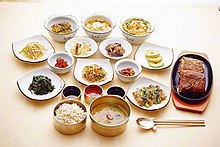Kimchi-jjigae
| Kimchi-jjigae | |
 | |
| Korean name | |
|---|---|
| Hangul | 김치찌개 |
| Revised Romanization | gimchi jjigae |
| McCune–Reischauer | kimch'i tchigae |
Kimchi jjigae (Korean pronunciation: [kimtɕʰi tɕ͈iɡɛ]) is a variety of jjigae, or stew-like Korean dish, made with kimchi and other ingredients, such as scallions, onions, diced tofu, pork, and seafood, although pork and seafood are generally not used in the same recipe. It is one of the most common jjigae in Korea.
History
Kimchi is known to have been eaten as pickled vegetables, and only became the kimchi known today in the mid-Joseon era, when red peppers were first introduced to the country. Kimchi jjigae is assumed to have been developed around this time, as well.[1]
Preparation and serving
Kimchi jjigae is often cooked in Korean homes using older, more fermented and "ripe" kimchi, creating a much stronger taste and containing higher amounts of "good" bacteria also found in yogurt.[2] The stew is said to be more flavorful if prepared with older kimchi, while fresh kimchi may not bring out a full and rich flavor. Kimchi is the most important ingredient in kimchi jjigae and other ingredients tend to depend on personal preferences.
Sliced kimchi is put into a pot with beef, pork or seafood, tofu, sliced spring onions and garlic, and are all boiled with water or myeolchi (anchovy) stock. The stew is seasoned with either doenjang (bean paste) or gochujang (red pepper paste).[1]
Like many other Korean dishes kimchi jjigae is usually eaten communally from the center of the table if more than two people are served. It is accompanied by various banchan (side dishes) and rice. It is usually cooked and served boiling hot in a stone pot.
Varieties
Besides the standard ingredients of beef, pork, or chicken, some varieties are called by their particular names.
- Chamchi kimchi jjigae (참치 김치찌개) is made with tuna, usually the canned type made specifically to use in jjigae. It is popular for camping trips or picnics, because it is easy to make.[3]
- Ggongchi kimchi jjigae (꽁치 김치찌개) is made with Pacific saury.
- Budae jjigae (부대찌개) is made by mixing a variety of ingredients - noodles (normally, ramen noodles), tuna, spam, vegetables, etc. - into the basic kimchi jjigae broth. "Budae" means "army unit" in Korea; this variety of kimchi jjigae was popular with soldiers, who found it convenient to mix in their leftovers into the jjigae broth.
See also
References
- ^ a b Template:Ko Kimchi jjigae at Encyclopedia of Korean Culture
- ^ Template:Ko Bacteria in kimchi, Doctor's News, 2009-05-18. Retrieved 2010-06-24.
- ^ Template:Ko Tuna in jjigae, Hankyung News, 2010-01-19. Retrieved 2010-06-24.
External links
 |
| This article is part of a series on |
| Korean cuisine 한국 요리 조선 료리 |
|---|
